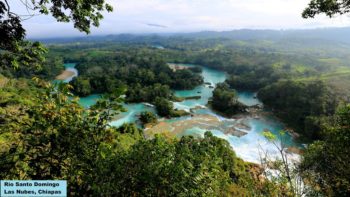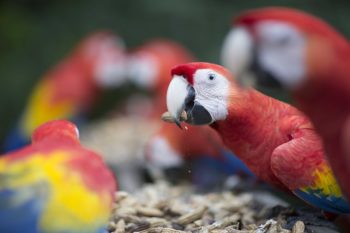The Lacandon Jungle in Mexico Posted by Karoly Molina on Jul 30, 2020 in Uncategorized
When you think of Mexico, you might picture a desert with cacti or beautiful blue beaches with a cocktail at hand. Something most people don’t visualize is the jungle, but Mexico houses the largest rainforest in North America. In this post, I want to explore the Selva Lacandona and some of the animals and plants you might find there.
Selva Lacandona
La Selva Lacandona lies at the south or sur of Mexico in the states of Yucatán and Chiapas and parts of Honduras. Large parts of the jungle have been destroyed, however, about 900,000 hectares still remain. It is the largest forest in North America and one of the few areas left for jaguares. According to the asociación civil sin fines de lucro or non-profit civil association Natura Mexicana, the jungle has about 3,400 plant species, of which 573 are trees, as well close to 50% of the bird and mammal population in the country. La Selva Lacandona is also home to several species en peligro de extinción like the jaguar, el tapir, la guacamaya roja, el aguila arpía, la tortuga blanca, y el cocodrilo pardo.
It is safe to say the Selva Lacandona is a vital area not only for Mexico, but for the entire North American continent.
Conservación de la selva
Like most natural reserves, the Selva Lacandona is always at risk. The current area is only one third of what once was there and there are constant threats to it. Sobrepoblación (overpopulation), agricultura (farming) and deforestación (deforestation) are some of the many threats or amenazas the area fases in addition to climate change.
The team at Natura Mexicana has been working in the area for many years to protect and monitor the area as well as to work together with the people living nearby to create proyectos sustentables y económicamente viables (sustainable and financially viable projects). This area faces many economical challenges, but Natura works together with the people to show them there are more ways to benefit from nature than farming. Some of the projects include an ecological hotel, a butterfly sanctuary, a restaurant, a centre for ecotourism, and camping grounds.
Natura has two stations within the Selva Lacandona that they use as a base for all their work. These are located at campo Chajul y Tzendales. From the station, they take part in monitoreo, investigación, capacitación y educación ambiental. These are at the heart of the protected area and provide valuable tools for research and conservation.
The video below explains more about the Selva Lacandona and the work of Natura Mexicana to protect it.
If you want to learn more about the Selva Lacandona, I invite you to check out the Facebook page of Natura Mexicana where they regularly share photos and videos of this beautiful natural treasure. You can also learn more about the tapir and the jaguar on their YouTube channel.
If you are in the mood for traveling, you can watch the following show from the cultural TV channel in Mexico. It follows three travellers, and, in this particular episode, they are in the Selva Lacandona.
What natural areas do you have in your countries? Are these areas well preserved?

Build vocabulary, practice pronunciation, and more with Transparent Language Online. Available anytime, anywhere, on any device.





